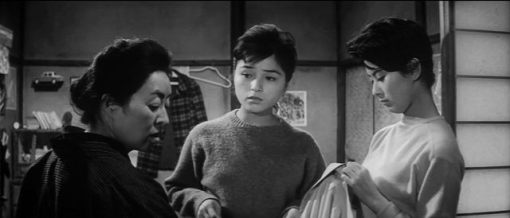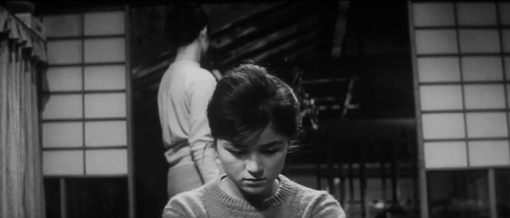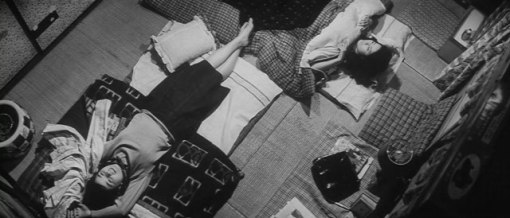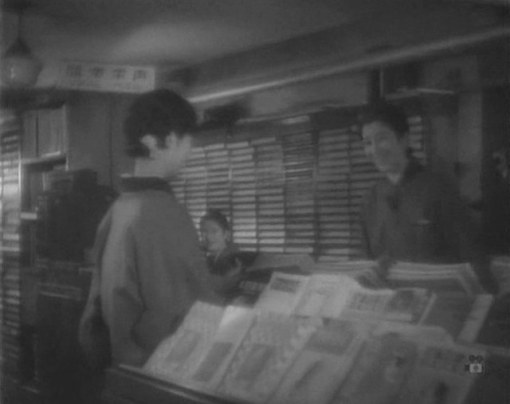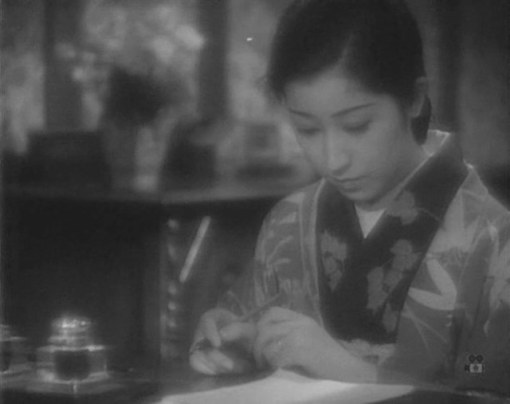One of Shinoda’s earliest features (he made Dry Lake earlier in 1961, and Koi no katamichi kippu from 1960 is listed as his debut) and one of the best from the little I’ve managed to see. It probably helps that although he still manages to work within the tradition of the Japanese New Wave, the content here doesn’t seem that disconnected from what he and filmmakers like Nagisa Oshima were supposedly rebelling against. The title itself seems like it could very well come from either Ozu or Naruse’s filmography. The film itself isn’t really fleshed out enough to stand alongside the works of those two filmmakers, but it is a wonderful attempt by a youngster at making something far more mature.
Keiko (Noriko Maki) and Saeko (Chieko Baisho) are sisters working desk jobs at the local factory to help keep their family afloat. Their father’s fishing business seems to be a day away from it’s demise. Despite both of them being in their twenties, they are the main source of income for their impoverished family, which bothers Keiko a great deal. She meets a childhood friend one day, who manages to sustain a life within the city just by being a flirty girl. This isn’t the ideal solution for Keiko, but when she’s introduced to a potential suitor, she takes note of his healthy income. Meanwhile, Saeko is pulling strings to make her sister fall in love with their coworker at the factory, Komakura.
For all of Shinoda’s technical strides, the biggest selling point here might be the fabulous cast. Chinese native Noriko Maki, who would later appear in Ozu’s An Autumn Afternoon and not much else, is excellent here. Eijirô Tôno, who frequently collaborated with Kurosawa and Ozu, is a wonderful fit for a father trying to maintain control of his household. His pained facial expressions are the perfect compliment to the beautifully photography documenting his sad attempt at income. His fishing business is likely going to end, and his desperation is never explicitly mentioned, but it is evident.
The best performance belongs to Chieko Baisho, who is probably less familiar to most. She made a career as Yoji Yamada’s muse, his own Setsuko Hara so to speak. She’s much different here than in Yamada’s films, where she frequently plays quiet but powerful independent women. This is not the case here, as she’s filled with youthful idealism that motivates her in playing matchmaker for her sister. Unlike Keiko, she believes that people can be happy without money. The two discuss this frequently, and it’s Shinoda’s intention to imply that there’s not a black and white answer. We see a seemingly happy but impoverished couple’s relationship dissolve right in front of the two sisters, but then Keiko herself is extremely upset by the behavior of her socialite friend.
There’s a lot to chew on here, more so than one might expect from a film with a running time of just 69 minutes. As mentioned before, there isn’t really enough there for this to feel like it even comes to close to the best Japanese domestic-driven dramas of the 50s and 60s. It’s just a quick character study, and it’s sort of imitating a more complicated one. The performances are fantastic, though, and it’s Baisho specifically who shines. Shinoda only does a few playful things with the camera, which shows some maturity especially compared to the hyper and kinetic early efforts of Oshima and Yoshishige Yoshida.
The beautiful photography is the work of Masao Kosugi, who would later work with Shinoda on Pale Flower and Assassination (both 1964), and it gives us some wonderful images. The sequence in which Keiko confronts Komakura is particularly stunning. The performers say and emote little, but the thickness of the atmosphere manages to heighten the tension. The wonderful garbage-laced landscapes manage to perfectly compliment the more deliberately framed compositions that take place inside.
We only get a glimpse of this world (barely more than an hour) but it’s a distinct experience. The recently reviewed The Angry Street purposed an interesting “what if?” to Naruse’s career had he focused his intentions on genre. Likewise, this film shows Shinoda using his talents for a domestic drama, which is a hundred times more interesting than the angst-driven, gangster-lite films he and his comrades were making for most of the early 60s. I might be in the minority here, but I think I would have preferred for him to make more films like this one.
